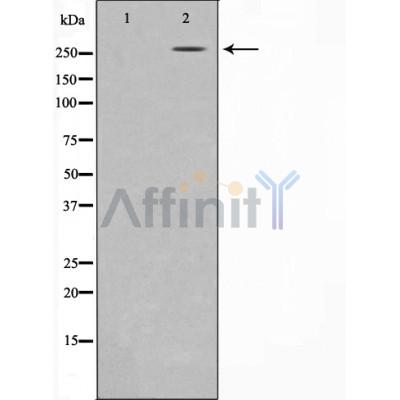AKAP13 Antibody - #DF3249
| Product: | AKAP13 Antibody |
| Catalog: | DF3249 |
| Description: | Rabbit polyclonal antibody to AKAP13 |
| Application: | WB IHC IF/ICC |
| Reactivity: | Human, Mouse |
| Mol.Wt.: | 307 KD; 308kD(Calculated). |
| Uniprot: | Q12802 |
| RRID: | AB_2835629 |
Product Info
*The optimal dilutions should be determined by the end user. For optimal experimental results, antibody reuse is not recommended.
*Tips:
WB: For western blot detection of denatured protein samples. IHC: For immunohistochemical detection of paraffin sections (IHC-p) or frozen sections (IHC-f) of tissue samples. IF/ICC: For immunofluorescence detection of cell samples. ELISA(peptide): For ELISA detection of antigenic peptide.
Cite Format: Affinity Biosciences Cat# DF3249, RRID:AB_2835629.
Fold/Unfold
A kinase (PRKA) anchor protein 13; A kinase anchor protein 13; A kinase anchoring protein; A-kinase anchor protein 13; AKAP 13; AKAP Lbc; AKAP-13; AKAP-Lbc; AKAP13; AKP13_HUMAN; ARHGEF13; Breast cancer nuclear receptor binding auxiliary protein; Breast cancer nuclear receptor-binding auxiliary protein; BRX; c lbc; FLJ11952; FLJ43341; Guanine nucleotide exchange factor Lbc; HA 3; HA3; Ht 31; Ht31; Human thyroid anchoring protein 31; Human thyroid-anchoring protein 31; LBC; LBC oncogene; Lymphoid blast crisis oncogene; Non oncogenic Rho GTPase specific GTP exchange factor; Non-oncogenic Rho GTPase-specific GTP exchange factor; p47; Protein kinase A anchoring protein 13; Protein kinase A-anchoring protein 13; PROTO LB; PROTO LBC;
Immunogens
A synthesized peptide derived from human AKAP13, corresponding to a region within the internal amino acids.
Detected in mammary gland (PubMed:9627117). Detected in heart (at protein level) (PubMed:11546812). Expressed as a 5.3 kb transcript in hematopoietic cells, skeletal muscle, lung, heart, estrogen-responsive reproductive tissues, including breast ductal epithelium. Also found in testis and breast cancer cell lines. Predominantly expressed as a 10 kb transcript in the heart and at lower levels in the lung, placenta, kidney, pancreas, skeletal muscle and liver. Transcripts of between 6-9 kb are also expressed in myeloid and lymphoid lineages, a variety of epithelial tissues, and in skeletal muscle.
- Q12802 AKP13_HUMAN:
- Protein BLAST With
- NCBI/
- ExPASy/
- Uniprot
MKLNPQQAPLYGDCVVTVLLAEEDKAEDDVVFYLVFLGSTLRHCTSTRKVSSDTLETIAPGHDCCETVKVQLCASKEGLPVFVVAEEDFHFVQDEAYDAAQFLATSAGNQQALNFTRFLDQSGPPSGDVNSLDKKLVLAFRHLKLPTEWNVLGTDQSLHDAGPRETLMHFAVRLGLLRLTWFLLQKPGGRGALSIHNQEGATPVSLALERGYHKLHQLLTEENAGEPDSWSSLSYEIPYGDCSVRHHRELDIYTLTSESDSHHEHPFPGDGCTGPIFKLMNIQQQLMKTNLKQMDSLMPLMMTAQDPSSAPETDGQFLPCAPEPTDPQRLSSSEETESTQCCPGSPVAQTESPCDLSSIVEEENTDRSCRKKNKGVERKGEEVEPAPIVDSGTVSDQDSCLQSLPDCGVKGTEGLSSCGNRNEETGTKSSGMPTDQESLSSGDAVLQRDLVMEPGTAQYSSGGELGGISTTNVSTPDTAGEMEHGLMNPDATVWKNVLQGGESTKERFENSNIGTAGASDVHVTSKPVDKISVPNCAPAASSLDGNKPAESSLAFSNEETSTEKTAETETSRSREESADAPVDQNSVVIPAAAKDKISDGLEPYTLLAAGIGEAMSPSDLALLGLEEDVMPHQNSETNSSHAQSQKGKSSPICSTTGDDKLCADSACQQNTVTSSGDLVAKLCDNIVSESESTTARQPSSQDPPDASHCEDPQAHTVTSDPVRDTQERADFCPFKVVDNKGQRKDVKLDKPLTNMLEVVSHPHPVVPKMEKELVPDQAVISDSTFSLANSPGSESVTKDDALSFVPSQKEKGTATPELHTATDYRDGPDGNSNEPDTRPLEDRAVGLSTSSTAAELQHGMGNTSLTGLGGEHEGPAPPAIPEALNIKGNTDSSLQSVGKATLALDSVLTEEGKLLVVSESSAAQEQDKDKAVTCSSIKENALSSGTLQEEQRTPPPGQDTQQFHEKSISADCAKDKALQLSNSPGASSAFLKAETEHNKEVAPQVSLLTQGGAAQSLVPPGASLATESRQEALGAEHNSSALLPCLLPDGSDGSDALNCSQPSPLDVGVKNTQSQGKTSACEVSGDVTVDVTGVNALQGMAEPRRENISHNTQDILIPNVLLSQEKNAVLGLPVALQDKAVTDPQGVGTPEMIPLDWEKGKLEGADHSCTMGDAEEAQIDDEAHPVLLQPVAKELPTDMELSAHDDGAPAGVREVMRAPPSGRERSTPSLPCMVSAQDAPLPKGADLIEEAASRIVDAVIEQVKAAGALLTEGEACHMSLSSPELGPLTKGLESAFTEKVSTFPPGESLPMGSTPEEATGSLAGCFAGREEPEKIILPVQGPEPAAEMPDVKAEDEVDFRASSISEEVAVGSIAATLKMKQGPMTQAINRENWCTIEPCPDAASLLASKQSPECENFLDVGLGRECTSKQGVLKRESGSDSDLFHSPSDDMDSIIFPKPEEEHLACDITGSSSSTDDTASLDRHSSHGSDVSLSQILKPNRSRDRQSLDGFYSHGMGAEGRESESEPADPGDVEEEEMDSITEVPANCSVLRSSMRSLSPFRRHSWGPGKNAASDAEMNHRSSMRVLGDVVRRPPIHRRSFSLEGLTGGAGVGNKPSSSLEVSSANAEELRHPFSGEERVDSLVSLSEEDLESDQREHRMFDQQICHRSKQQGFNYCTSAISSPLTKSISLMTISHPGLDNSRPFHSTFHNTSANLTESITEENYNFLPHSPSKKDSEWKSGTKVSRTFSYIKNKMSSSKKSKEKEKEKDKIKEKEKDSKDKEKDKKTVNGHTFSSIPVVGPISCSQCMKPFTNKDAYTCANCSAFVHKGCRESLASCAKVKMKQPKGSLQAHDTSSLPTVIMRNKPSQPKERPRSAVLLVDETATTPIFANRRSQQSVSLSKSVSIQNITGVGNDENMSNTWKFLSHSTDSLNKISKVNESTESLTDEGVGTDMNEGQLLGDFEIESKQLEAESWSRIIDSKFLKQQKKDVVKRQEVIYELMQTEFHHVRTLKIMSGVYSQGMMADLLFEQQMVEKLFPCLDELISIHSQFFQRILERKKESLVDKSEKNFLIKRIGDVLVNQFSGENAERLKKTYGKFCGQHNQSVNYFKDLYAKDKRFQAFVKKKMSSSVVRRLGIPECILLVTQRITKYPVLFQRILQCTKDNEVEQEDLAQSLSLVKDVIGAVDSKVASYEKKVRLNEIYTKTDSKSIMRMKSGQMFAKEDLKRKKLVRDGSVFLKNAAGRLKEVQAVLLTDILVFLQEKDQKYIFASLDQKSTVISLKKLIVREVAHEEKGLFLISMGMTDPEMVEVHASSKEERNSWIQIIQDTINTLNRDEDEGIPSENEEEKKMLDTRARELKEQLHQKDQKILLLLEEKEMIFRDMAECSTPLPEDCSPTHSPRVLFRSNTEEALKGGPLMKSAINEVEILQGLVSGNLGGTLGPTVSSPIEQDVVGPVSLPRRAETFGGFDSHQMNASKGGEKEEGDDGQDLRRTESDSGLKKGGNANLVFMLKRNSEQVVQSVVHLYELLSALQGVVLQQDSYIEDQKLVLSERALTRSLSRPSSLIEQEKQRSLEKQRQDLANLQKQQAQYLEEKRRREREWEARERELREREALLAQREEEVQQGQQDLEKEREELQQKKGTYQYDLERLRAAQKQLEREQEQLRREAERLSQRQTERDLCQVSHPHTKLMRIPSFFPSPEEPPSPSAPSIAKSGSLDSELSVSPKRNSISRTHKDKGPFHILSSTSQTNKGPEGQSQAPASTSASTRLFGLTKPKEKKEKKKKNKTSRSQPGDGPASEVSAEGEEIFC
Research Backgrounds
Scaffold protein that plays an important role in assembling signaling complexes downstream of several types of G protein-coupled receptors. Activates RHOA in response to signaling via G protein-coupled receptors via its function as Rho guanine nucleotide exchange factor. May also activate other Rho family members. Part of a kinase signaling complex that links ADRA1A and ADRA1B adrenergic receptor signaling to the activation of downstream p38 MAP kinases, such as MAPK11 and MAPK14. Part of a signaling complex that links ADRA1B signaling to the activation of RHOA and IKBKB/IKKB, leading to increased NF-kappa-B transcriptional activity. Part of a RHOA-dependent signaling cascade that mediates responses to lysophosphatidic acid (LPA), a signaling molecule that activates G-protein coupled receptors and potentiates transcriptional activation of the glucocorticoid receptor NR3C1. Part of a signaling cascade that stimulates MEF2C-dependent gene expression in response to lysophosphatidic acid (LPA) (By similarity). Part of a signaling pathway that activates MAPK11 and/or MAPK14 and leads to increased transcription activation of the estrogen receptors ESR1 and ESR2. Part of a signaling cascade that links cAMP and EGFR signaling to BRAF signaling and to PKA-mediated phosphorylation of KSR1, leading to the activation of downstream MAP kinases, such as MAPK1 or MAPK3. Functions as scaffold protein that anchors cAMP-dependent protein kinase (PKA) and PRKD1. This promotes activation of PRKD1, leading to increased phosphorylation of HDAC5 and ultimately cardiomyocyte hypertrophy (By similarity). Has no guanine nucleotide exchange activity on CDC42, Ras or Rac. Required for normal embryonic heart development, and in particular for normal sarcomere formation in the developing cardiomyocytes (By similarity). Plays a role in cardiomyocyte growth and cardiac hypertrophy in response to activation of the beta-adrenergic receptor by phenylephrine or isoproterenol. Required for normal adaptive cardiac hypertrophy in response to pressure overload. Plays a role in osteogenesis (By similarity).
Cytoplasm>Cytosol. Cytoplasm. Cytoplasm>Cell cortex. Nucleus. Membrane>Peripheral membrane protein.
Note: Colocalizes with the actin cytoskeleton at the cell cortex.
Detected in mammary gland. Detected in heart (at protein level). Expressed as a 5.3 kb transcript in hematopoietic cells, skeletal muscle, lung, heart, estrogen-responsive reproductive tissues, including breast ductal epithelium. Also found in testis and breast cancer cell lines. Predominantly expressed as a 10 kb transcript in the heart and at lower levels in the lung, placenta, kidney, pancreas, skeletal muscle and liver. Transcripts of between 6-9 kb are also expressed in myeloid and lymphoid lineages, a variety of epithelial tissues, and in skeletal muscle.
The DH domain is sufficient for interaction with RHOA, and for guanine nucleotide exchange (GEF) activity with RHOA (PubMed:24993829). Forms that lack C-terminal regulatory domains have transforming activity and function as oncogenes (PubMed:9891067).
The PH domain does not play a role in lipid-binding. Instead, it inhibits the guanine nucleotide exchange (GEF) activity of the isolated DH domain (in vitro).
The C-terminal domain after the PH domain is involved in protein-protein interactions that are required for normal, compensatory cardiac hypertrophy in response to pressure overload.
Restrictive clause
Affinity Biosciences tests all products strictly. Citations are provided as a resource for additional applications that have not been validated by Affinity Biosciences. Please choose the appropriate format for each application and consult Materials and Methods sections for additional details about the use of any product in these publications.
For Research Use Only.
Not for use in diagnostic or therapeutic procedures. Not for resale. Not for distribution without written consent. Affinity Biosciences will not be held responsible for patent infringement or other violations that may occur with the use of our products. Affinity Biosciences, Affinity Biosciences Logo and all other trademarks are the property of Affinity Biosciences LTD.

